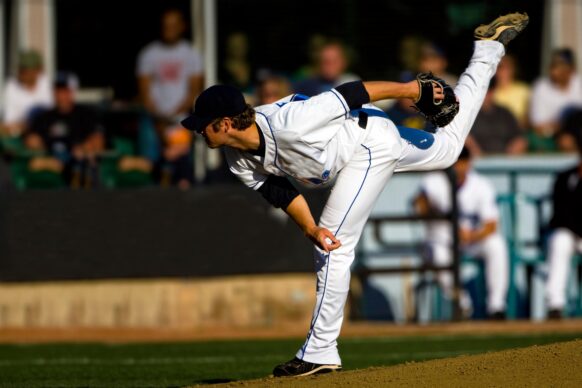by Thomas Martinho, PT, DPT
While goals are scored above the water, elite water polo players and coaches will tell you what happens below the water is just as important to the success of a player and their team. Players must utilize their legs to keep their head above the water, push to create space and hold position, balance themselves while passing, propel themselves with and without the ball, and create power for shooting. Water polo players use a variety of techniques to create these forces however the most vital and frequently used kick is the egg beater. To eggbeater, a player alternates moving their legs in a circular and downward motion. This pattern requires hip mobility in all planes, but especially flexion, abduction, external and internal rotation. Decreased mobility in any of these directions will lead to decreased efficiency of the kick and potential overuse injury.
A water polo player must have both strength and controlled mobility through the hips and lower extremities. Try some of the exercises below to increase mobility for a smoother more efficient eggbeater kick.
Banded Hip Mobilization Exercises
(10-20 reps, each direction)
These exercises are used to improve joint mobility. Different positions and band placements target different planes of motion utilized during an eggbeater kick. Anchor a thick, elastic band to a pole or other solid object. Place the band around the thigh, as close to the hip joint as possible. You should feel a slight stretch deep in the hip. Best performed prior to practice or weight room.
Adductor Rock Back
This exercise will help with hip abduction as well as improve hamstring mobility. Starting on hands and knees, kick one leg directly out to the side at the same height as the opposite knee. While keeping the leg straight, sit back into heels until a stretch is felt on the inside of the leg. Return to the starting position and repeat. Perform on both sides.
Hip 90/90 w/ Internal Rotation
This exercise is designed to help improve Internal rotation (IR) at the hip. Start by sitting on the floor with feet flat, just wider than hip-width, and knees spread apart. From this position rotate hips and knees to the right bringing both knees as close to the ground as possible. Your ending position should be with the trunk upright, thighs perpendicular to each other, and both knees at 90 degrees. You should feel a stretch in the side of your left hip. From this position, while keeping both knees on the ground, you can try to lift your left foot to improve active IR. Perform 10-15 lifts. Challenge yourself by switching to the other side without using your hands. Do not perform if you feel a painful pinch in the groin area.
Hip Flexor Stretch
Start in a half-kneeling position with your back foot up on a ball or bench. Make sure that core is engaged to prevent pelvic anterior tilt, this will ensure the stretch is at the hip and avoids compensation at the back. While slightly pushing hips forward, reach up with the arm on the same side as the leg being stretched elongating the torso. A stretch should be felt along the front of the hip and thigh in the back leg. If the stretch is too intense, you can place your back foot on the ground and slowly progress as tolerated.
Hip CARs (8-10 reps, each side)
This exercise helps with active mobility, hip control, and fluidity of hip movement. While performing this exercise, focus on minimizing movement at the pelvis and back. Bring the knee forward as far as possible without rounding at the back. Next, abduct the hip, bringing the knee out to the side. While keeping the foot wide, rotate leg pointing foot towards the sealing. Finally, bring the knee back to the starting position and perform in the reverse direction.
Please reach out with any questions or to expand your mobility and training program.




